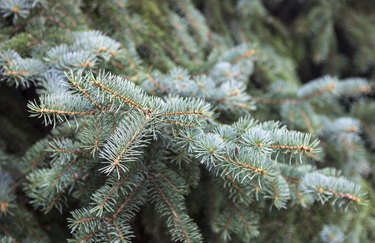Good ornamental trees to plant near a house include trees that stay small in structure; provide color in the form of flowers, interesting bark or fall foliage; and have characteristics that are interesting during more than one season. Ornamental trees are small trees that create visual interest and have smaller root systems that won't damage house foundations.
Flowering Trees
Video of the Day

Flowering trees provide a burst of color, usually in the spring and come in a range of flower colors.
Video of the Day
Flowering Dogwood
Flowering dogwoods (Cornus florida), hardy in U.S. Department of Agriculture zones 5 through 9, are native trees that bloom in spring. Dogwoods come in shades of pink and white and have delicate branch patterns, making them an elegant addition near a house. Flowering dogwoods tolerate shade and are a good choice for locations that don't receive full sun.
Eastern Redbud
Eastern redbuds (Cercis canadensis), hardy in USDA zones 4 through 8, are spring flowering trees that remain small in stature. They have attractive delicate purple or white flowers and heart-shaped leaves. Select cultivars have purple leaves, allowing for contrast with other nearby plants.
Purple Leaf Plum
Purple leaf plums (Prunus cerasifera), hardy in USDA zones 3 through 9, are often found in front yard landscapes due to their spring flowers and attractive purple foliage. The delicate light pink flowers bloom in spring and the purple foliage contrasts with green foliage.
Trees with Interesting Bark

While people may not think of tree bark when selecting a tree for their homes, some trees provide great interest all year long due to their bark.
River Birch
River birches (Betula nigra), hardy in USDA zones 4 through 9, have exfoliating bark that makes them a showy choice for front landscapes near homes. Its vase-like shape and delicate branching allow it to work well near a building. The peeling light-colored bark creates visual interest all year long.
Coral Bark Maple
Coral bark maples (Acer palmatum 'Sango-kaku'), hardy in USDA zones 5 through 8, are particularly striking in winter when their bright orange-red bark stands out starkly. Coral bark maples are slow growing and one of the smaller ornamental trees, eventually reaching 20 feet in height, and can fit into small areas where planting space is minimal.
Paperback Maple
Paperbark maples (Acer griseum), hardy in USDA zones 4 through 7, are another choice for trees with exfoliating bark. This slow growing ornamental has curling reddish brown bark and tolerates shade. Paperbark maples are symmetrical in appearance and have delicate maple shaped leaves.
Evergreen Trees

Evergreen trees come in a variety of shades of green, grey and blue and thus can provide great curb appeal near a home. Smaller varieties and varieties that have a weeping growth habit can provide varying structural elements and color interest near a home.
Colorado Blue Spruce
The Colorado blue spruce cultivar 'Fat Albert' (Picea pungens '_Fat Albert'),_ hardy in USDA zones 3 through 7, is a compact blue spruce with a vibrant blue grey color that stays small for a blue spruce reaching 15 feet at its maximum height. This conically-shaped evergreen provides year around interest.
Weeping Blue Atlas Cedar
Weeping blue atlas cedar (Cedrus atlantica 'Glauca Pendula'), hardy in USDA zones 6 through 7, have pendulous branches and blue-green needles. Because these are specimens, they vary in form and provide a focal point in front of foundation plantings.
- Texas Tech University: Purple Leaf Plum
- Missouri Botanical Garden: Cercis canadensis
- Missouri Botanical Garden: Cornus florida
- Missouri Botanical Garden: Betula nigra
- Missouri Botanical Garden: Picea pungens 'Fat Albert'
- Missouri Botanical Garden: Acer griseum
- Missouri Botanical Garden: Acer palmatum 'Sango-Kaku'
- Missouri Botanical Garden: Cedrus atlantica (Glauca group) 'Glauca Pendula'